The New Browning 20-Gauge 725 Sporting is a Gem
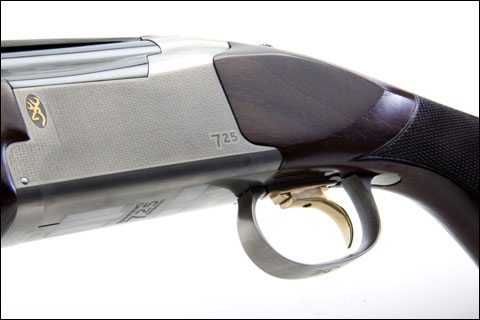
If you’re still shooting that beloved Browning over/under you’ve owned since college, be prepared to have your socks knocked off with the company’s new 20-Gauge 725 Sporting.
Although still a member of the fabled Citori family introduced in 1973, the 20-gauge 725 Sporting marks a departure from classic Browning over/unders characterized by broad beaver tail forends, bulky receivers and labored handling. To paraphrase that Oldsmobile meme, the 20-gauge 725 is “not your father’s Browning.”
The company will tell you that the Citori 725 family, introduced in 2012 with a 12 gauge, is an evolution of John M. Browning’s legendary B25 Superposed. We would argue that the Citori 725 — the 20-gauge Sporting in particular — is more of a quantum leap. The Browning 20-gauge 725 Sporting packages graceful handling and a seamless finish into an over/under that surpasses Italian shotguns costing twice the price.
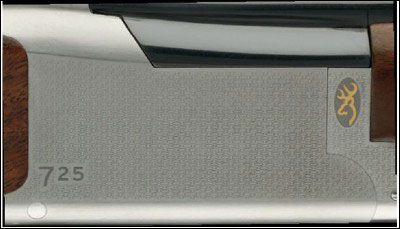
The receiver of the Browning 20-gauge 725 Sporting.
So what’s the rub? If you’re a devotee of engraved false sideplates you probably won’t be convinced to purchase the Citori 725 20-gauge Sporting. The receiver is matte silver nitride with a delicate, bracelet cable chain pattern. Its subtlety and tone appear somewhat monotonous against the eye-catching Grade III/IV oil-finished, black walnut with its closed-radius pistol grip and palm swell.
As a contemporary minimalist design, the receiver disappoints in avant-garde elegance compared with Beretta’s 692 or the Blaser F3. A black receiver with simulated carbon-fiber stippling would’ve put the world on notice with a supercar fascia for the 725 20-gauge Sporting. Oh well.
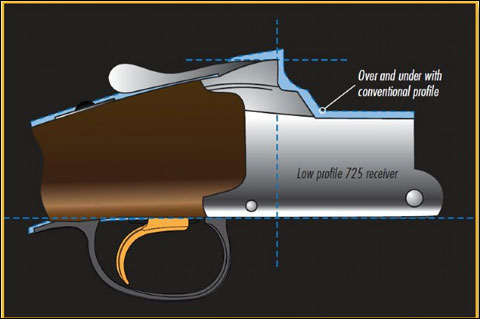
This rendition supplied by Browning shows the lower receiver in the 725.
Compared to previous Citoris, Browning managed to reduce the width and height of the 725 receiver a few millimeters by engineering shorter, stronger hammers and dropping the barrels lower into the receiver. The objective was to change the relationship of your cheek and eye to the rib itself — placing face, eyes and hands closer to the shotgun’s centerline. We experienced the “in-line feeling” that Browning describes in shooting the 725 Sporting, although “intuitive” is the description that comes to mind when shooting it.
The Browning 725 Sporting 20 gauge delivers high-performance handling, perhaps not quite up to a $10,000 Perazzi, but nonetheless fast, responsive and neutral. With 30-inch, ported barrels, our 20 gauge weighed 6 pounds, 6 ounces. Bottom line: the 20-gauge 725 Sporting is one of the easiest and enjoyable over/unders to shoot. In fact, it can be downright exhilarating.

The 20-gauge Browning 725 Sporting.
The 14¾-inch length of pull, 1-9/16-inch drop at comb and 2-3/16-inch drop at heel suited my average frame. Shouldering the shotgun from the ready position proved smooth and comfortable — ultimately providing a clear, whole target picture.
Browning’s new Fire Lite Mechanical Trigger played a starring role in the shotgun’s inspiring performance. A historic departure from Browning’s Superposed and Citori inertia triggers, the Fire Lite Mechanical Trigger delivered a flawless pull that averaged 3½ pounds — matching the weight you’d find on the likes of a world-class Krieghoff. The trigger’s take-up and travel was smooth and predictable, to the extent that it seemed to enhance your focus with a precise punctuation of the shot at target break point.
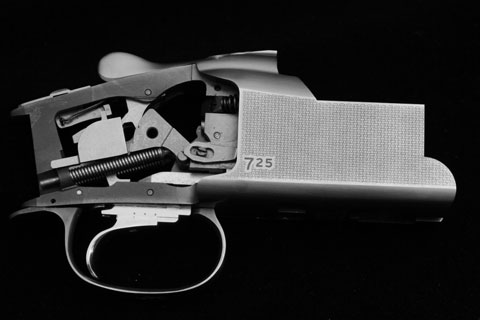
The action of Browning’s 20-gauge 725 Sporting.
The so-called Triple Trigger System allows for an adjustable length of pull plus two gold-plated trigger shoes (wide checkered or narrow smooth).
A new Inflex II Technology recoil pad also contributed to the shotgun’s appeal. Beneath the Inflex II soft pad is a skeleton computed for directional deflection. Upon firing a shot, the pad collapses, but instead of simply shifting aft, in a micro-second the system directs the comb from your face for comfort and recovery. In practice, we experienced near-zero recoil and muzzle jump — allowing us to remain snugly in the gun for that second shot of a true pair.
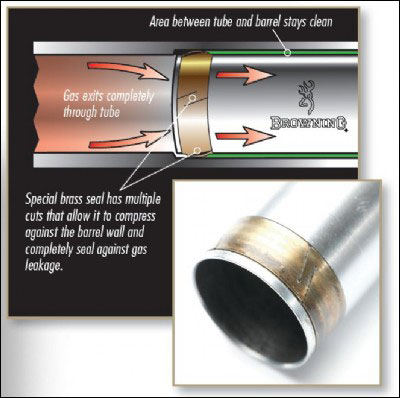
Browning’s illustration describes the brass seal on their Invector-DS choke system.
The 725 Citori features Browning’s new Invector-DS (Double Seal) Choke System. Browning says it provides better patterning, lighter weight and a sleeker barrel profile. The combination of muzzle-end treads and thin-wall construction allows for a longer, more gradually tapered choke tube that results in more evenly scaled patterns. The Invector-DS also features a proprietary brass seal at the base of the choke that prevents gas and grit from slipping between the barrels.
Just a quick note about the chokes. The five standard screw-ins have the same famous orange band as improved cylinder on the Briley Spectrum choke series. Browning’s Invector-DS constrictions are marked on the middle of the tube. So when you open the box of chokes for the first time, relax, you didn’t really get five ICs.
On the sporting clays course, the chokes complemented Browning’s back-bored barrels and the elongated forcing cones called Vector Pro. Browning claims the barrels deliver more uniform patterns and reduced pellet deformity over earlier Citoris. Although we didn’t pattern the 20-gauge 725 Sporting per se, we started on novice sporting-clays targets of easy incomers and outgoers to evaluate pellet spreads, which powdered clay targets comprehensively. We also discovered that our 725 Sporting shot relatively flat — a personal preference.
Moving to progressively more difficult stations, there were authoritative breaks on sporting-clays targets out to 50 yards using off-the-shelf ⅞-ounce, #8 shot ammo, although the three-inch chambers can handle stepped-up loads. Fitted with modified and full chokes, centered breaks certainly outnumbered chips for us.
We’re not believers in a fluorescent front bead, but if you subscribe to that school of shooting enjoy the interchangeable HiViz Pro-Comp sights that come with the shotgun.
Expect the 725 Sporting to continue Browning’s tradition of bank-vault dependability. A bolt-like hinge pin runs the full-width of the receiver. When closed, the chopper lump plus two lumps beneath the underlug bite protrude through the floor of the receiver for additional strength over trunnion designs. Nothing revolutionary here, but the effect is a sturdy, wobble-free unit. (See Nick Sisley’s review of the Browning Citori 725 and revived A5 shotguns on Shotgun Life at http://tinyurl.com/jw35dv3.)
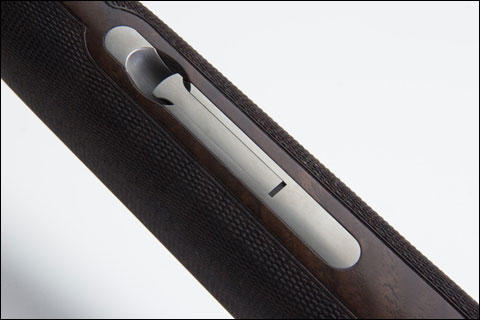
Excellent fit and finish shown here on the Browning 725 Sporting 20-gauge.
After each round, breaking open our brand, new shotgun remained tight and jerky through all 300 rounds of sporting clays. Otherwise, fit and finish ranked as tops. The proud, slender forend corresponded flush against the receiver while the underlever had no gaps against the inletting (likewise for the trigger guard). Ejectors were strong. Trigger was awesome. All the tolerances appeared scientifically precise — giving rise to that old adage about the steel constituents machined from a single billet.
Browning’s 20-gauge 725 Sporting is a well-executed, honest shotgun that is beautiful to shoot. Available with 30-inch and 32-inch barrels that have vented side ribs, the suggested price is $3,139.
Irwin Greenstein is the Publisher of Shotgun Life. You reach him at contact@shotgunlife.com.
Useful resources:
The 725 Sporting page on the Browning web site

Irwin Greenstein is Publisher of Shotgun Life. Please send your comments to letters@shotgunlife.com.


Comments